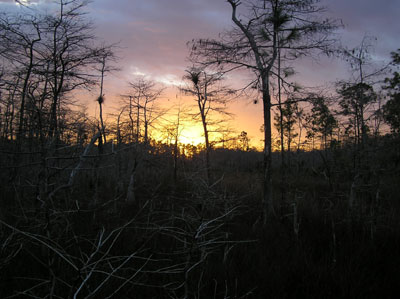
January: The beginning of another wonderful day in the Big Cypress Swamp. In the early morning light the leafless fingers of cypress tree branches reminds one of a medieval setting, with creatures from ancient history.
A person doesn't have to let their mind fantasize to much to imagine an ancient past. This natural setting has not been disturbed too much from its ancient past. Rising from the sea, this land was barren coral rock reef, that gradually over hundreds of years deposited soil, enough to support land vegetation and creatures.
The current day alligator has not changed all that much from its ancient beginnings. I can't help but wonder what this land was like during its prehistoric days? (A copy of this picture is located on my favorite pictures page, suitable for printing).
These two creatures were cautiously finding and eating kernels of corn under the game feeder next to camp. The mom a little braver then the offspring venturing out into the open area. The youngster, either more timid or acting as taught by mom was more nervous about moving into the opening and more quick to run to cover at any unusual noise.
Unfortunately, the young coon was orphaned a few days after this picture, because mom was not cautious enough. Subsequent game camera pictures show a maturing young coon still in the area.

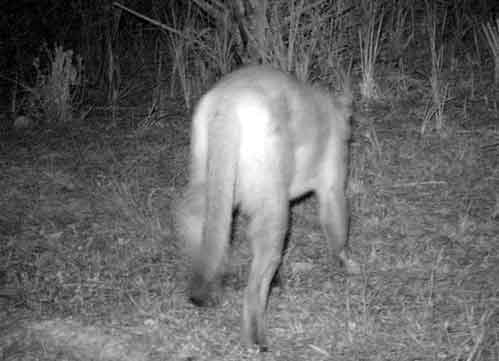
In fact, it is almost more common now to see panther tracks than it is to see raccoon tracks. While you still have to walk some distance to eventually see panther tracks, the same is true for raccoon tracks now a days. Most of the raccoons have become panther food, along with the armadillos and possums.
For those that may question it's ability, it is far from any road and certainly had to be capable to get to its final resting place. Several swamp vehicles, that reached the end of their useable life, now rest in the swamp, slowly fading from the history of the swamp.

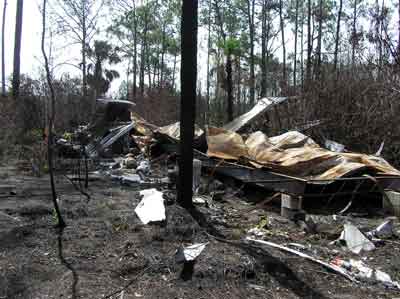
June: The Jarhead wild fire claimed three camps. Actually four, because this property, counted as one by the National Park Service actually had two camps on it.
This camp built by father and now owned by sons, suffered total ruin in this swamp fire that burned for days and burned thousands of acres.
The chore of rebuilding back in the swamp, surrounded by Nation Park Land is a daunting task. But not a task that a Gladesman with a long history in the swamp will give up on. I wish this family the best in the rebuilding of these camps.
On a fine day for hunting, the game camera catches a hunter passing by on his way to a hunting stand in the swamp. While this spot is where a game feeder is located, it is never hunted.
On private property, it is posted as "no hunting" and its purpose is in seeing and enjoying watching animals. Even though in a three week period the game camera may take hundreds of pictures, you can sit and watch the spot and be lucky to see an animal in person.
Animals are so in tune with nature and have a high sense of awareness, it is rare you can sit still enough for animals to approach and not notice you. The animals, particularly turkeys. will visit at almost the same time during the day. They may skip a day, but when they return, it will be almost at the same time as the previous visit.


Moving to use a video camera and switching to a still camera, the deer eventually had enough of the movement, flagged, spun away and ran into a nearby cypress head. After not being pursued, the doe deer, returned to the more open area, continuing to graze, but setting a course away from the hunter. Still visible to the view of the elevated hunter, the deer eventually faded into the distance.
This Florida Black bear has become a regular at the game feeder. Standing and sniffing the corn in the feeder, it does not want to settle for a few kernels of corn on the ground. This bear has successful torn down the feeder several times and gorged itself on corn. Not the only bear that visits the feeder, but certainly the biggest, it has a very commanding size to it. Fortunately, black bears are very shy and retreat at the sight or sound of man.
The nearby camp, over the years we have owned it, has been broken into by bears, three times. We finally smartened up and do not leave any scent of food in the buildings and that was the end of the break ins. Even with the proximity of this feeder being close to the cabin, the bears will leave foot print smudges on the cabin walls, but seem to know there is no incentive to break in. It has been almost ten years since the last break in.
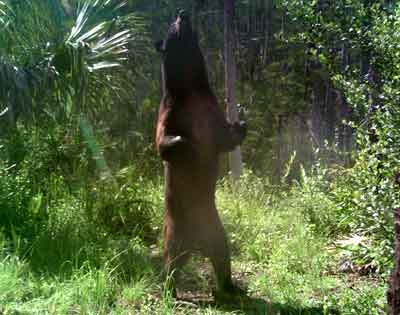
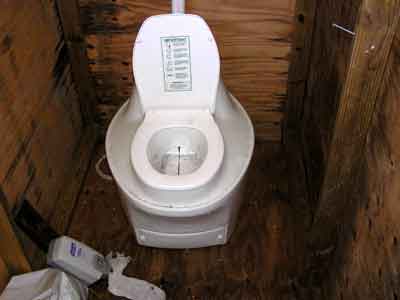
With all the concern at the present time about sanitary systems in the Big Cypress Swamp, the Nation Park Service has built an out house and installed a BioToilet at the NPS camp. All these years the NPS has used this camp with no sanitary facilities. Of course the NPS being a federal government entity, is exempt from local and state laws. The only exception to this is the Clean Water Act requires them to meet local and state laws on water pollution. Something they continue to ignore, not getting required storm water treatment permits as required by state law.
They are in the process of installing some sort of sanitary tank at the NPS camp. Apparently it is a slow process in getting it built and finished. It will be interesting to see what its final construction looks like and how it functions.
This November hunting morning breakfast is being prepared in the Camp Sixpack kitchen. Starting the bacon cooking and an iron skillet of potatoes on the stove, breakfast preparation is under way.
One of my favorite meals is breakfast. Hoss is an excellent cook and never a complaint is heard about meals at Sixpack. While the inside of the kitchen has a cluttered and well, primitive look to it, fine meals are produced here.
The morning breakfast table, occupied by coffee drinking hunters has heard many hunting stories. Some of which can be repeated and others not. Some of my most enjoyable times are sitting at this table while swamp stories and yarns are told.
